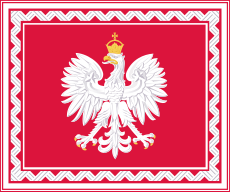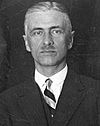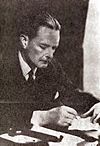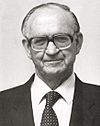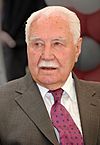Polish government-in-exile facts for kids
Quick facts for kids
Government of the
Republic of Poland in exile Rząd Rzeczypospolitej Polskiej
na uchodźstwie (Polish) |
|||||||||||
|---|---|---|---|---|---|---|---|---|---|---|---|
| 1939–1990 | |||||||||||
|
Anthem: Poland Is Not Yet Lost
|
|||||||||||
| Status | Government in exile | ||||||||||
| Capital | Warsaw (de jure) Capital in Exile Paris (1939–1940) Angers (1940) London (1940–1990) |
||||||||||
| Common languages | Polish | ||||||||||
| Government | Government-in-exile | ||||||||||
| President | |||||||||||
|
• 1939–1947 (first)
|
Władysław Raczkiewicz | ||||||||||
|
• 1989–1990 (last)
|
Ryszard Kaczorowski | ||||||||||
| Prime Minister | |||||||||||
|
• 1939–1943 (first)
|
Władysław Sikorski | ||||||||||
|
• 1986–1990 (last)
|
Edward Szczepanik | ||||||||||
| Historical era | World War II and Cold War | ||||||||||
| 17 September 1939 | |||||||||||
|
• Presidency ceded by Ignacy Mościcki to Władysław Raczkiewicz
|
30 September 1939 | ||||||||||
|
• Sikorski–Mayski agreement
|
30 July 1941 | ||||||||||
|
• Loss of wide diplomatic recognition
|
5 July 1945 | ||||||||||
|
• Diplomatic recognition withdrawn by last country
|
19 October 1972 | ||||||||||
| 22 December 1990 | |||||||||||
|
• Liquidation of apparatus accomplished
|
31 December 1991 | ||||||||||
|
|||||||||||
The Polish government-in-exile was Poland's official government during and after World War II. It was formed in September 1939 after Nazi Germany and the Soviet Union invaded and occupied Poland. This event ended the Second Polish Republic.
Even though Poland was occupied, the government-in-exile had a big impact. It worked through the Polish Underground State and its military, the Armia Krajowa (Home Army). Polish soldiers who escaped the occupation also fought with Allied forces around the world.
After the war, Poland came under communist rule. The government-in-exile continued to exist, but it lost most of its power. Many countries stopped recognizing it by July 1945. The United Kingdom still supported it informally. The last country to stop recognizing it was the Holy See (Vatican City) in 1972.
The government-in-exile finally handed over its powers in 1990. This happened after communist rule ended in Poland. The handover took place at a special ceremony in Warsaw. The government-in-exile was based in France from 1939 to 1940, first in Paris and then in Angers. From 1940, after France was invaded, it moved to London and stayed there until 1990.
Contents
History of the Government in Exile
How the Government Started
On September 17, 1939, Poland's President, Ignacy Mościcki, was near the border. He announced his plan to transfer power. He chose Władysław Raczkiewicz, the head of the Senate, as his successor. This was allowed by Poland's 1935 Constitution.
The Constitution said that if war happened, the President's term would continue. If the President's job became empty during the war, he would name a successor. This new President's term would end three months after peace was made.
Mościcki resigned on September 29 or 30, 1939. Raczkiewicz was in Paris and immediately took his oath. He became the new President of Poland. Raczkiewicz then chose General Władysław Sikorski as Prime Minister. Sikorski also became the Commander-in-Chief of the Polish Armed Forces.
Many Polish Navy ships went to Britain. Thousands of Polish soldiers and airmen escaped through Hungary and Romania. Others crossed the Baltic Sea to continue fighting in France. These Poles later fought in many Allied operations. They were in Norway, France, the Battle of Britain, North Africa, and Italy.
In July 1941, the Sikorski–Mayski agreement was signed. This agreement freed Polish soldiers captured by the Soviet Union in 1939. They formed Anders' Army to fight Nazi Germany. However, they moved to Iran and then fought with US and British forces. Another Polish army, Berling's Army, was formed in the USSR in 1944. It stayed and fought under Soviet command.
During World War II
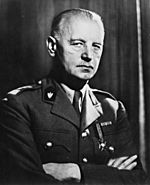
The Polish government in exile was first in Paris, then in Angers, France. President Władysław Raczkiewicz lived near Angers from December 1939 to June 1940. After France fell, the government moved to London. All Allied governments recognized it there. It was a mix of different political parties.
When Germany attacked the Soviets in 1941, the Polish government in exile started working with the Soviet Union. This was to fight Hitler and help Poles who were being treated badly by the Soviet secret police. On August 12, 1941, the Soviets offered a special pardon. This freed thousands of Polish soldiers captured in 1939. It also freed many Polish civilians sent to Siberia.
This pardon allowed Poles to create eight military groups called the Anders Army. They were sent to Iran and the Middle East. The British needed their help against Erwin Rommel's forces. These Polish units became the Polish II Corps. Led by General Władysław Anders, they fought alongside the Allies.
During the war, especially from 1942, the Polish government in exile shared important information with the Allies. They gave early and accurate reports about the terrible events happening to Jewish people in Europe. Polish representatives, like Foreign Minister Edward Bernard Raczyński and underground courier Jan Karski, asked for action.
On December 10, 1942, Foreign Minister Raczyński sent a note to the United Nations. This was the first time any government officially spoke out about the mass killing of Jewish people. It was also the first official document to highlight the suffering of European Jews as Jews. This note led to the Allied Nations' Declaration on December 17, 1942.
In April 1943, the Germans announced a discovery. They found mass graves of Polish officers at Katyn Wood in Russia. These officers were captured in 1939 and killed by the Soviets. The Soviet government said the Germans made it up. Other Allied governments accepted this for diplomatic reasons. But the Polish government in exile refused to believe it.
Because of this, Joseph Stalin ended relations with the Polish government in exile. This was a big problem for Poland. It was clear that the Soviet Union, not the Western Allies, would free Poland. Sadly, in July 1943, Sikorski, a strong Polish leader, died in a plane crash. Stanisław Mikołajczyk became the new head of the government in exile.
During 1943 and 1944, Allied leaders like Winston Churchill tried to get Stalin and the Polish government to talk again. But they couldn't agree on several things. One was the Katyn massacre. Another was Poland's future borders. Stalin wanted to keep the lands the Soviets took in 1939. He said Poland should get land from Germany instead. Mikołajczyk did not want to give up Poland's pre-war eastern lands.
A third issue was Mikołajczyk's demand that Stalin not set up a Communist government in Poland. The government-in-exile wanted to keep Poland's borders from before 1939. But Stalin already controlled that land. The exiles' refusal to accept new borders made the Allies less willing to argue with Stalin about Poland's future government. In the end, the exiles lost on both issues. Stalin kept the eastern lands. He also set up a communist government in Poland. In November 1944, Mikołajczyk resigned and went back to Poland.
After the War
On June 28, 1945, Mikołajczyk joined the Provisional Government of National Unity. This new government was set up by the Soviets. This allowed the Western Allies to accept that Poland was now in the Soviet sphere of influence. They recognized the new government and stopped recognizing the government-in-exile. France did this on June 29, 1945. The United States and United Kingdom followed on July 5, 1945.
The Polish Armed Forces in exile were disbanded in 1945. Most of their members could not safely return to communist Poland. They settled in other countries. Many Polish exiles disagreed with this. They believed the new government was just a way to set up communist rule. This was proven true in 1947 when the communists won a rigged election.
The Polish government in exile kept going in London. It had to leave the Polish embassy. It only kept the president's private home. The government became a symbol of resistance against foreign control of Poland. It also kept important historical records.
In 1954, there was a disagreement within the government in exile. Some people thought President August Zaleski should not continue his term. They formed a new group and chose three people to act as head of state. These were Tomasz Arciszewski, General Władysław Anders, and Edward Bernard Raczyński. The two groups reunited after Zaleski died in 1972.
Some supporters of the government in exile eventually returned to Poland. The Soviet-backed government in Warsaw encouraged exiles to come back. They promised jobs and forgiveness. The Republic of Ireland, Francoist Spain, and finally the Holy See (Vatican City) in 1972 were the last countries to stop recognizing the government-in-exile.
Despite these challenges, the government in exile continued. When Soviet influence in Poland ended in 1989, it still had a president and a small group of ministers. They met every two weeks in London. They were supported by about 150,000 Polish veterans and their families in Britain.
End of the Government in Exile
After communist rule ended in Poland in 1989, the government-in-exile officially passed its powers to the new Polish government. This happened on December 22, 1990, at the Royal Castle in Warsaw. Lech Wałęsa, Poland's first non-Communist president since the war, received the symbols of the Polish Republic. These included the presidential banner, seals, sashes, and the original 1935 Constitution.
The London-based government officially closed down on December 31, 1991. In 1992, military medals and awards given by the government in exile were officially recognized in Poland. The last President-in-exile also received the same rights and benefits as former presidents in Poland.
Leaders of the Government
Presidents
| No. | President | Took office | Left office | Time in office | Party | |
|---|---|---|---|---|---|---|
| 1 | Władysław Raczkiewicz (1885–1947) |
30 September 1939 | 6 June 1947 † | 7 years, 249 days | Independent | |
| 2 | August Zaleski (1883–1972) |
9 June 1947 | 8 April 1972 † | 24 years, 304 days | Independent | |
| 3 | Stanisław Ostrowski (1892–1982) |
9 April 1972 | 24 March 1979 | 6 years, 349 days | PPS | |
| 4 | Edward Bernard Raczyński (1891–1993) |
8 April 1979 | 8 April 1986 | 7 years, 0 days | Independent | |
| 5 | Kazimierz Sabbat (1913–1989) |
8 April 1986 | 19 July 1989 † | 3 years, 102 days | Independent | |
| 6 | Ryszard Kaczorowski (1919–2010) |
19 July 1989 | 22 December 1990 | 1 year, 156 days | Independent |
Prime Ministers
| No. | Portrait | Name (born–died) |
Term of office | Political party | Ref. | |||
|---|---|---|---|---|---|---|---|---|
| Took office | Left office | Time in office | ||||||
| 1 |  |
Władysław Sikorski (1881–1943) |
30 September 1939 | 19 July 1940 | 293 days | Independent | ||
| 2 |  |
August Zaleski (1883–1972) |
19 July 1940 | 25 July 1940 | 6 days | Independent | ||
| 1 |  |
Władysław Sikorski (1881–1943) |
25 July 1940 | 4 July 1943 † | 2 years, 344 days | Independent | ||
| 3 |  |
Stanisław Mikołajczyk (1901–1966) |
14 July 1943 | 24 November 1944 | 1 year, 133 days | Polish People's Party | ||
| 4 |  |
Tomasz Arciszewski (1877–1955) |
29 November 1944 | 2 July 1947 | 2 years, 215 days | Polish Socialist Party | ||
| 5 |  |
Tadeusz Bór-Komorowski (1895–1966) |
2 July 1947 | 10 February 1949 | 1 year, 223 days | Independent | ||
| 6 |  |
Tadeusz Tomaszewski (1881–1950) |
7 April 1949 | 25 September 1950 | 1 year, 171 days | Independent | ||
| 7 |  |
Roman Odzierzyński (1892–1975) |
25 December 1950 | 8 December 1953 | 3 years, 74 days | Independent | ||
| 8 |  |
Jerzy Hryniewski (1895–1978) |
18 January 1954 | 13 May 1954 | 115 days | Polish Independence League | ||
| 9 |  |
Stanisław Mackiewicz (1896–1966) |
8 June 1954 | 21 June 1955 | 1 year, 13 days | Independent | ||
| 10 |  |
Hugon Hanke (1904–1964) |
8 August 1955 | 10 September 1955 | 33 days | Labour Faction | ||
| 11 |  |
Antoni Pająk (1893–1965) |
10 September 1955 | 14 June 1965 | 9 years, 277 days | Polish Socialist Party | ||
| 12 |  |
Aleksander Zawisza (1896–1977) |
25 June 1965 | 9 June 1970 | 4 years, 349 days | Independent | ||
| 13 |  |
Zygmunt Muchniewski (1896–1979) |
20 July 1970 | 13 July 1972 | 1 year, 359 days | Labour Faction | ||
| 14 |  |
Alfred Urbański (1899–1983) |
18 July 1972 | 15 July 1976 | 3 years, 363 days | Polish Socialist Party | ||
| 15 |  |
Kazimierz Sabbat (1913–1989) |
5 August 1976 | 8 April 1986 | 9 years, 246 days | Independent | ||
| 16 |  |
Edward Szczepanik (1915–2005) |
8 April 1986 | 22 December 1990 | 4 years, 258 days | Independent | ||
Polish Armed Forces
The Polish government-in-exile had control over various military groups. These groups fought bravely during World War II.
- Association of Armed Struggle (ZWZ)
- Home Army (Armia Krajowa)
- Grey Ranks (Szare Szeregi)
- Polish resistance movement in World War II
- Polish Armed Forces in the West
- Polish Armed Forces in the East
See also
- Tadeusz Chciuk-Celt, special envoy of the government
- Ignacy Schwarzbart
- Szmul Zygielbojm
- Henryk Leon Strasburger, Finance Minister and Minister in the Middle East for the Sikorski government; Ambassador to London for Mikolajczyk
- Juliusz Nowina-Sokolnicki, alternative President of the Republic of Poland (1972–1990)
- Polish Committee of National Liberation (Polish: Polski Komitet Wyzwolenia Narodowego; PKWN), 1944–1945
- "Western betrayal"




